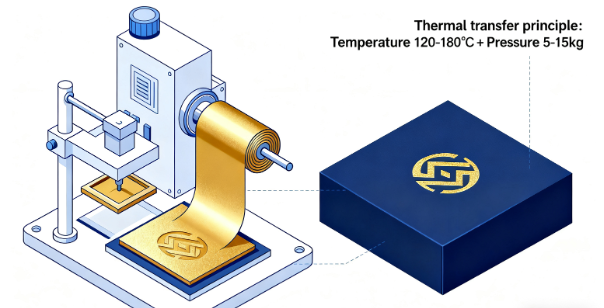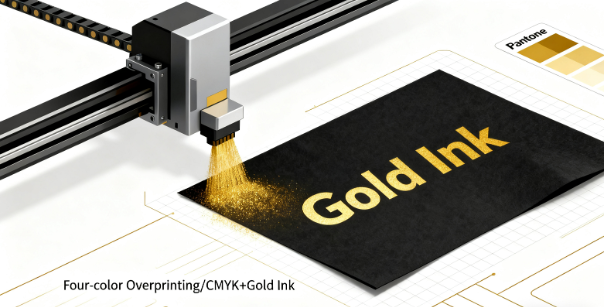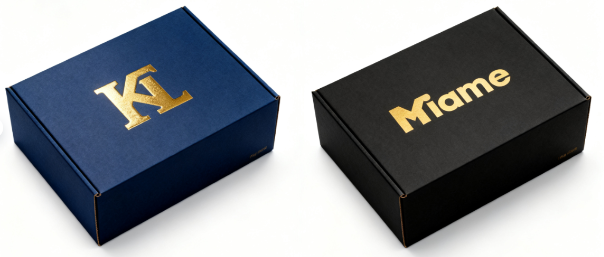Introduction
In the field of packaging, the golden element is the most widely used because gold can effectively attract customers' attention. There are two common techniques to achieve a golden effect: one is the hot stamping process, and the other is the golden printing process. For ordinary consumers, these two appear very similar. However, from the perspective of professionals, the differences between them are significant. This article will provide a comprehensive guide to the golden effect, covering aspects such as process, cost, and final result.
Differences
Process-wise
Gold Foil Stamping is a process of heat transfer printing, where gold foil or other colors are transferred onto the surface of the box through heating and pressure.
It requires a specially crafted stylizing plate to create patterns or text with gold foil and a three-dimensional effect.

Gold Printing involves using various techniques, such as digital printing, screen printing, or offset printing.
In digital printing and offset printing, gold can be achieved through Pantone's metallic inks or through the four-color printing process by blending colors to achieve a gold effect. Screen printing generates a gold effect through the blending of metallic inks.
Cost-wise
The upfront cost of gold foil stamping is high because the mold cost is relatively high and can vary depending on the size and complexity of the mold. Additionally, the gold foil itself incurs a cost. Therefore, for small batches, the cost of gold foil stamping can be very expensive. However, for large-scale production, the unit cost will significantly decrease, making it a highly effective investment for those purchasing in large quantities to make the packaging appear more upscale.
Gold printing is a very economical option for those who have less stringent packaging requirements. Since it does not require expensive mold costs, the cost is mainly related to the ink, and it is relatively more favorable for small batches, making it suitable for large-scale color application.
Effect
Gold foil stamping features a textured appearance that reflects varying sheens as the angle of light changes, creating an elegant impression and enhancing brand value. It is also highly durable and resistant to fading, as the gold foil does not easily peel off.
The durability of gold printing is comparatively lower. It tends to fade over time with prolonged use. Additionally, the golden effect remains unchanged with variations in light, making it more suitable for mass-produced items requiring cost control, such as flyers and posters.
Others
The gold stamping process has several limitations. For example, it may struggle to achieve a good effect on very thin lines or extremely small fonts. However, the gold printing process can display a variety of intricate details.
Furthermore, the gold stamping process offers a selection of multiple gold foil colors, catering to diverse consumer needs. On the other hand, gold printing can only be adjusted within the range of controllable golden ink.
Summary
Gold foil stamping and gold printing are two distinct processes for achieving a golden effect, each with its own advantages and limitations. The gold foil stamping process is more suitable for manufacturing high-end and durable products. Its golden effect not only has a textured appearance but also exudes an elegant feel. However, it comes with a higher cost and lower flexibility in customization. On the other hand, gold printing has a lower cost, is more environmentally friendly, and offers greater flexibility in customization, making it ideal for mass production and personalized designs. Nonetheless, its visual effect is not as refined as that of gold foil stamping, and its durability is inferior.
Therefore, when selecting a process, it is essential to clearly understand one's core requirements. If an elegant appearance and durability are priorities, the gold foil stamping process should be preferred. Conversely, if cost and diverse customization needs are valued, gold printing is more suitable. Understanding these differences enables the selection of the most appropriate process, thereby meeting actual needs and achieving the desired golden effect.
Jianyon is equipped with highly professional stamping and printing equipment, capable of meeting your diverse needs.
FAQ
What is the main visual difference between gold foiling and gold printing?
Gold foiling creates a raised, tactile surface with a metallic sheen that changes with light angles, giving a premium feel. Gold printing lies flat on the paper and has a consistent color, making it less reflective but suitable for detailed designs.
Which method is more cost-effective for small-batch packaging orders?
Gold printing is more economical for small batches because it requires no custom molds. Gold foiling has high upfront tooling costs, making it cost-effective only for larger quantities.
Can gold printing replicate intricate designs better than foiling?
Gold printing excels at reproducing fine lines, small text, and complex gradients. Foiling may struggle with extremely delicate details due to the physical stamping process.
 EN
EN
 AR
AR
 BG
BG
 DA
DA
 NL
NL
 FI
FI
 FR
FR
 DE
DE
 IT
IT
 JA
JA
 KO
KO
 NO
NO
 PT
PT
 RU
RU
 ES
ES
 IW
IW
 TH
TH
 MS
MS
 HY
HY








